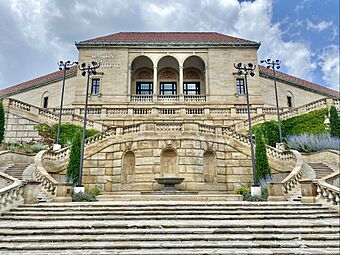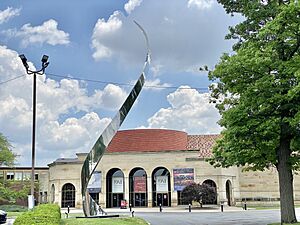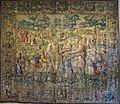Dayton Art Institute facts for kids
Quick facts for kids |
|
|
Dayton Art Institute
|
|
 |
|
| Location | Forest and Riverview Aves., Dayton, Ohio |
|---|---|
| Area | 6 acres (2.4 ha) |
| Built | 1930 |
| Architect | Edward B. Green |
| Architectural style | Renaissance, Italian Renaissance Revival |
| NRHP reference No. | 74001579 |
| Added to NRHP | November 19, 1974 |
The Dayton Art Institute (DAI) is a cool art museum in Dayton, Ohio, USA. It's known for having amazing art from all over the world and different times in history. People even say it's one of the best art museums in the U.S. for kids! It's also ranked very high among art museums in North America.
Contents
A Look Back: The Museum's Story
The Dayton Art Institute started way back in 1919. It was first called the Dayton Museum of Fine Arts. It began in a large house downtown.
In 1930, the museum moved to a brand-new building. This building was designed by a famous architect named Edward Brodhead Green. The design was inspired by beautiful old buildings in Italy. For example, it looks a bit like the Casino in the gardens of the Villa Farnese. The grand stairs outside were inspired by the Villa d'Este in Italy.
The building first had special roof tiles from Italy. But the cold Ohio winters were too harsh for them. So, in 1979, they were replaced with stronger tiles. The museum building is easy to see from the I-75 highway.
Later, the museum changed its name to the Dayton Art Institute. This showed that its art school was becoming very important too. The building is about 60,000 square feet. It is now listed on the National Register of Historic Places. This means it's a special historical place.
What You Can See: Museum Collections
The museum has a huge collection of art. There are more than 20,000 art pieces! These objects cover 5,000 years of history. That's a lot of art!
In 2005, the museum hosted a very special show. It was called The Quest for Immortality: Treasures of Ancient Egypt. This was the biggest collection of ancient Egyptian items ever to travel outside Egypt.
The museum building itself is beautiful. It's built in an Italian Renaissance style. It sits on top of a hill. From there, you can look down over downtown Dayton. Some of the most important parts of the museum's collection include:
- Art from Asia
- Art from the 1600s (called Baroque art)
- American art from the 1700s and 1800s
- Modern art (called contemporary art)
Besides its main collections, the museum often has new and exciting exhibitions.
Famous Artworks You Might See
The Dayton Art Institute has many famous and interesting artworks. Here are some of them:
- The Song of the Nightingale by William-Adolphe Bouguereau
- Purple Leaves by Georgia O'Keeffe
- Cantata by Norman Lewis
- Untitled by Joan Mitchell
- Sea Change by Helen Frankenthaler
- Untitled by Louise Nevelson
- Louise Nevelson by Alison Van Pelt
- Lost and Found by Alison Saar
- Embroidery from Uzbekistan by Janet Fish
- Sawdy by Edward Kienholz
- Study Heads of an Old Man by Peter Paul Rubens
- High Noon by Edward Hopper
- Aurora Red Ikebana with Bright Yellow Stems by Dale Chihuly
- After the Bath by Edgar Degas
- Stacks in Celebration by Charles Sheeler
- Scene in Yosemite Valley by Albert Bierstadt
- Allegory of the Four Seasons by Bartolomeo Manfredi
- Water Lilies by Claude Monet
- American Indian Series (Russell Means) by Andy Warhol
- Homage to Painting by Roy Lichtenstein
- Shimmering Madness by Sandy Skoglund
Gallery
-
The Song of the Nightingale by William-Adolphe Bouguereau, 1895
-
The Clock Tower, Venice by Francesco Guardi, 1760
-
Water Lilies by Claude Monet, 1903
-
High Noon by Edward Hopper, 1949
See also











